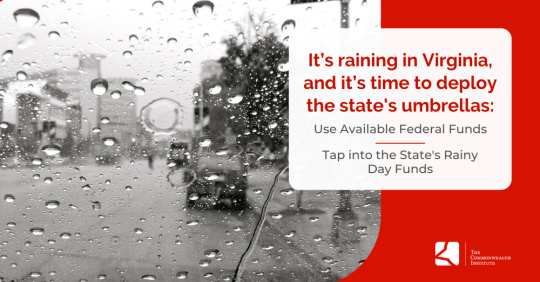September 2, 2020
Virginia Families Are Facing Hunger and Instability Due to the Pandemic: Legislators Should Use Available Federal Funds and Reserves to Help
Too many Virginia families and small businesses are struggling to stay afloat and pay their rent or mortgage in the face of continued devastation from COVID-19 on the main street economy and our daily lives, even as tech stocks drive the stock market to record highs. With consumer spending hurt by high unemployment rates for everyday working people in Virginia and a slow rebound in the service industry and brick-and-mortar retailers, state sales tax revenue is projected to be well below levels from a year ago. The state is also projecting much slower growth in employee income tax withholdings compared to pre-pandemic assumptions. This means that less new state revenue is available even as families, schools, and communities need more help to meet the economic and health crises. The good news is that the state of Virginia has available resources to help meet these increased needs, and policymakers can choose during this special session to deploy those resources to help communities navigate this challenging time.
In particular, policymakers have yet to allocate $1.3 billion of the $3.1 billion the state received from the Coronavirus Relief Fund in the federal CARES legislation. State leaders currently have until Dec. 30 to spend these funds and it’s critical that leaders direct these resources to families and communities. The state has also yet to make use of the $1 billion it has wisely saved in its two reserve funds, which can also play a critical role during this time.
The challenges Virginia faces
Before the impact of COVID-19, the economists and business leaders involved in the state revenue forecasting process expected employment, personal income, and state revenue to continue growing over the next several years, resulting in $22.7 billion in general fund revenue during the current fiscal year (FY 2021) and $23.5 billion in revenue in the next fiscal year (FY 2022). Given the necessary adjustments to daily life to protect public health during the COVID-19 pandemic, Virginia’s economic and revenue forecasters have sharply reduced those projections, resulting in a $1.3 billion (5.9%) reduction in forecasted revenue in FY 2021 and a $1.4 billion (5.7%) reduction in FY 2022.
At the same time state revenues are forecast to decrease, Virginia families need more financial help to prevent a rise in hunger and housing insecurity. Even before the $600/week federal boost to unemployment insurance benefits expired, 10% of Virginia adults reported that their household sometimes or often didn’t have enough to eat in the last seven days, a share that jumps to 18% of adults who are living in families with children. And 1 in 5 adult renters in Virginia was already behind on rent in mid-July. All told, about 400,000 children in Virginia were living in households where there wasn’t enough to eat or they were behind on their rent or mortgage. We expect these numbers to grow as the $600/week boost in unemployment benefits expired at the end of July. The pending CDC order halting some evictions until the end of December is an important step, yet it does not cancel unpaid rent or provide any money toward rental relief. As a result, without further help from the state, the CDC order may not reduce the total number of evictions, instead just delaying them until January.
Virginia has available state and federal resources to help meet these needs, and not spending them risks leaving money on the table
The challenges facing Virginia right now are significant, but the good news is there is money available to help meet these needs. This includes the state’s own reserves that are intended to be used to offset the impact of economic and revenue downturns, increased federal aid to help state and local policymakers meet the health and economic challenges, and options to raise new revenue.
Federal aid includes flexible funds that must be spent by December 30
The most immediate and largest of these is the federal assistance that has been provided to help state and local governments meet the needs of their communities. While these funds are insufficient to fully meet the needs of Virginia communities and more federal aid is needed (as well as more direct assistance to impacted workers and families), Virginia policymakers should be sure to fully use those funds that have been provided.
| Major Federal COVID-19 Aid for Virginia | ||
|---|---|---|
| Program/Agency | Description | Amount |
| Coronavirus Relief Fund (state and local) | Flexible support for state and local governments to address the health and economic crises. Fairfax County received an automatic allocation of $200 million of these funds; Gov. Northam has allocated funds to other localities based on population. | $3,310,000,000 |
| Provider relief funds | Direct payments to hospitals and other providers to address COVID-related costs | $1,806,863,962 |
| Enhanced FMAP | Higher federal match rate for Medicaid and related services, helping to offset general fund and special health care fund costs. The portion that offsets general fund spending helps offset the expected decrease in general fund revenue. This estimate assumes the federal health emergency continues through all of FY 2021. | $1,360,966,817 |
| Federal Transit Administration | Support for transit providers to meet current challenges | $456,399,000 |
| Airports | Support for airports in Virginia to meet current challenges | $309,729,000 |
| Elementary & Secondary Education Fund | Assistance to K-12 schools in meeting increased costs | $238,599,000 |
| Higher Education Relief Fund | Assistance to colleges & universities based on enrollment; 50% must be used for emergency financial aid grants to students | $294,391,000 |
| Child care development block grants | Support for childcare providers to meet current challenges | $70,799,000 |
| Governor’s Emergency Education Relief Fund | Flexible funding for to help K-12 schools, colleges, and universities meet the current challenges | $66,775,000 |
| Higher Education – HBCUs/MSIs | Flexible funding for Historically Black Colleges & Universities and Minority-Serving Institutions to address student and institutional needs | $41,014,000 |
| Other support from the Families First, CARES, and other recent Acts | Additional federal grants for public health, human services, and other needs | $338,381,000 |
| (Note: Table excludes direct relief to individuals and businesses such as the improvements to unemployment insurance, Paycheck Protection Program, and economic impact payments.) |
The largest of these, the Coronavirus Relief Fund (CRF), is also the most flexible, yet Virginia policymakers have not yet committed or allocated all these funds, creating a risk that some may go unspent by the December 30 deadline despite the urgent need to help Virginia families stay afloat.
Unlike other federal funds that are tied to existing federal-state programs or are directed toward specific uses, state policymakers have greater discretion around the CRF. Expenditures must adhere to federal guidelines, including that spending be “necessary” and “incurred due to the public health emergency.” Under current law, these funds cannot replace general revenue shortfalls or cover costs that were already in the state budget when the CARES Act was enacted in March. In the April version of the state budget, legislators accepted language that provided the governor with the authority to allocate the CRF funds without further legislative action (legislators could choose during the current special session to restrict that authority or dedicate some funds to particular purposes).
Virginia’s total CRF allocation from the federal government is $3.3 billion, of which $200 million was provided directly to Fairfax County, given the locality’s large population. Of the remaining $3.1 billion, the governor’s administration has committed or allocated about $1.8 billion, primarily ($1.3 billion) in the form of support to other local governments. Other allocations include $173 million for the Virginia Department of Emergency Management for testing, personal protective equipment, and other emergency response; $70 million for Small Business Assistance Grants; $59 million for the Virginia Department of Health for contact tracing and UVA equipment; $56 million to support long-term care facilities; and $50 million for mortgage and rental assistance. Of these commitments, Virginia reported about $771 million in actual spending through the end of June, almost entirely in providing assistance to local governments.
It is unclear if Virginia will use CRF money to provide an additional state share of the temporary federal UI benefit boost. Doing so could cost about $135 million for the initial three weeks and an additional $45 million for each additional week that is approved.
However, even if Virginia does that, there is additional flexible Coronavirus Relief Fund money that is not yet committed or allocated by the administration. Under current federal law, any funds that are unspent by December 30 will need to be returned to the U.S. Treasury.
| Virginia Has Not Yet Allocated All Flexible Coronavirus Relief Fund Money | |
|---|---|
| Support for local governments | $1,289,146,766 |
| Testing, PPE, and other Dept of Emergency Management | $173,060,401 |
| Contact tracing and other Dept of Health | $62,448,914 |
| Small Business Assistance Grants | $70,000,000 |
| Long-Term Care Facilities Support | $55,640,872 |
| Mortgage and Rental Assistance | $50,000,000 |
| Personal Protective Equipment for Personal Care Attendants | $9,256,178 |
| Emergency Housing for the Homeless | $8,828,998 |
| Food security | $3,861,953 |
| Other | $86,533,371 |
| Total from Treasury | $3,109,502,836 |
| Allocated to date | $1,808,777,453 |
| Remaining | $1,300,725,383 |
Virginia’s revenue reserves and unspent balances should be used to smooth the impact of the pandemic on families and communities
Policymakers in Virginia have wisely put money away over the last three years to help meet Virginia’s needs during an economic downturn. And through a hiring freeze and other actions, the governor’s administration increased the amount of cash that Virginia has on hand in addition to the two reserve funds. While maximizing the use of federal resources should be the first step, policymakers should also make use of the state’s own tools to address the impact of the pandemic and meet the growing needs of a growing population.
Using some of these funds should not negatively impact Virginia’s credit rating. In general, rating agencies have indicated that drawing down rainy day funds is appropriate during a downturn as part of a comprehensive budget strategy. “Rating agencies typically favor states that design their rainy day funds to align with turns in the economic cycle by depositing revenue during good times and spending those reserves when things turn bad” (Jeff Chapman, Airlie Loiaconi & Sheanna Gomes, Pew Charitable Trusts).
Long-term structural balance – having ongoing revenue that is sufficient to meet the state’s ongoing expenses under reasonable assumptions about economic growth – is also, rightly, an important consideration for rating agencies. This is evaluated by rating agencies in the context of the economic cycle; withdrawing money from rainy day funds during economic expansions would generally be viewed negatively by rating agencies. However, Virginia and the U.S. as a whole are not in an economic expansion, and the short-term use of reserve funds to meet the needs of state residents during a downturn is not the same thing as a long-term structural imbalance. Additionally, many of the needed interventions to protect Virginia families from the pandemic, such as additional rent and mortgage relief, are not ongoing expenses.
Policymakers can invest in protecting Virginia families and communities during pandemic
There are a number of ways that legislators could use the available federal and state funds to help Virginia families during the current health and economic challenges. These include additional rent and mortgage relief, food assistance for families who are struggling without employment, unemployment insurance payments for immigrant families and others who have been left out of federal help, sick leave and hazard pay for public sector and healthcare workers, removing barriers to health insurance for certain legally present immigrants, and reallotting funding for K-12 schools to help them meet the increased challenges of education during a pandemic. In some cases, the governor’s proposed budget uses state resources to help meet the increase in needs (for example, the governor’s budget proposal uses the TANF trust fund to provide food assistance to families with children in Head Start), yet more help is needed, and policymakers should consider using available CRF funds before tapping the state’s funds.
Virginia policymakers do not need to reinvent the wheel in order to help families and communities get by. Other states are using federal funds and state reserves to meet the needs of their communities at this time. For example, Oregon is using $35 million of federal funds to provide $500 one-time payments to any worker who has been impacted by job-related income loss. Hawaii has provided $100 million in housing assistance, Pennsylvania has provided $175 million in rent and mortgage assistance, and Florida has provided at least $240 million to help keep people in their homes. Maine has used $176 million to purchase a three-month supply of personal protective equipment for K-12 schools. And Iowa provided $57 million for child care providers. These are just a few examples from the National Conference of State Legislature roundup of how states are using CRF money. States are also using reserves to, for example, limit cuts to K-12 education support.
The COVID-19 pandemic and resulting recession are highly unusual events. Virginia policymakers have done a good job over the last three years of preparing the state for unexpected events by saving money in the state reserve funds. Now policymakers should use these funds, as well as available federal funds, to help families and communities stay afloat. It’s raining in Virginia, and it’s time to deploy our umbrellas.

Category:
Budget & Revenue

